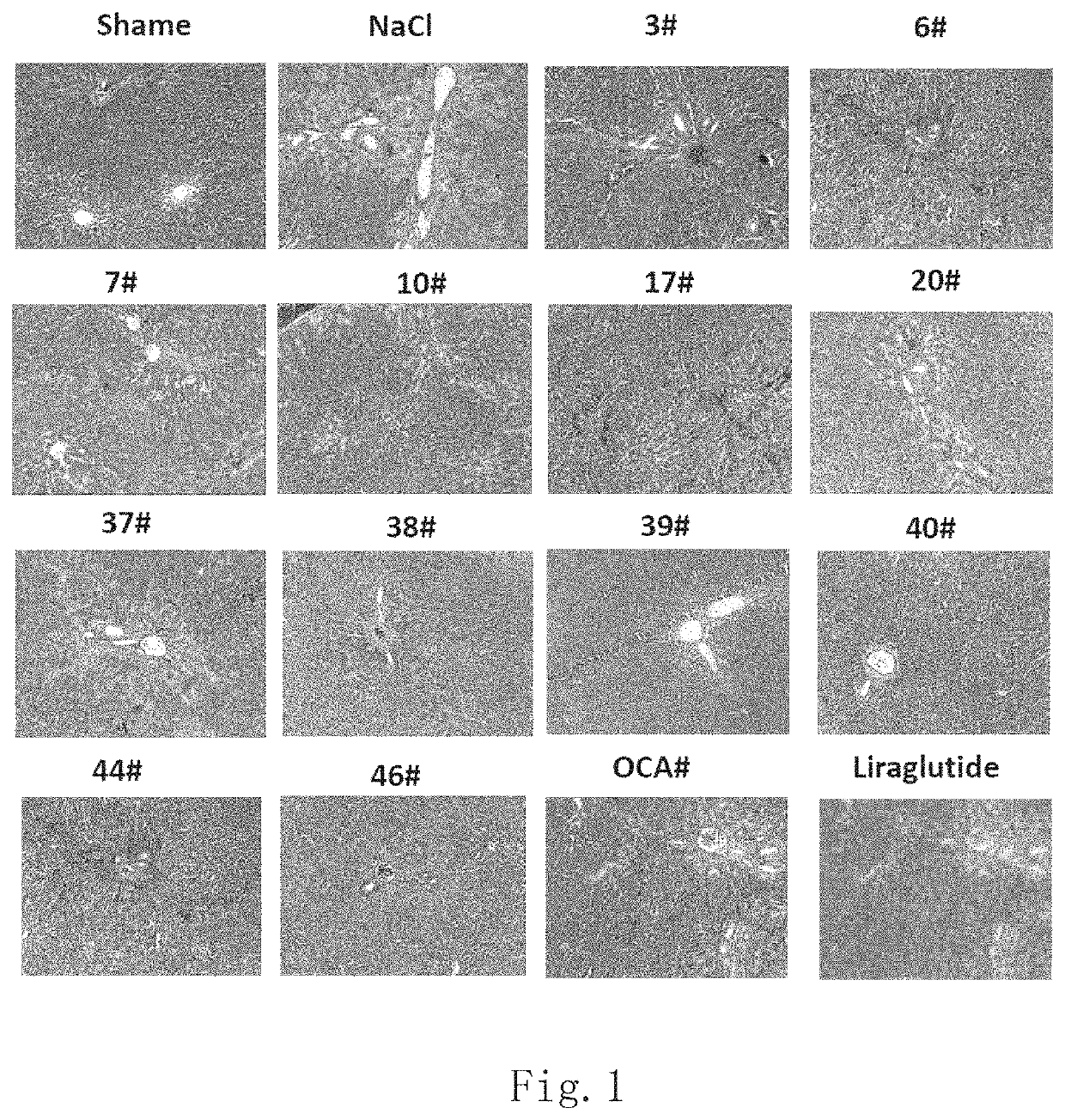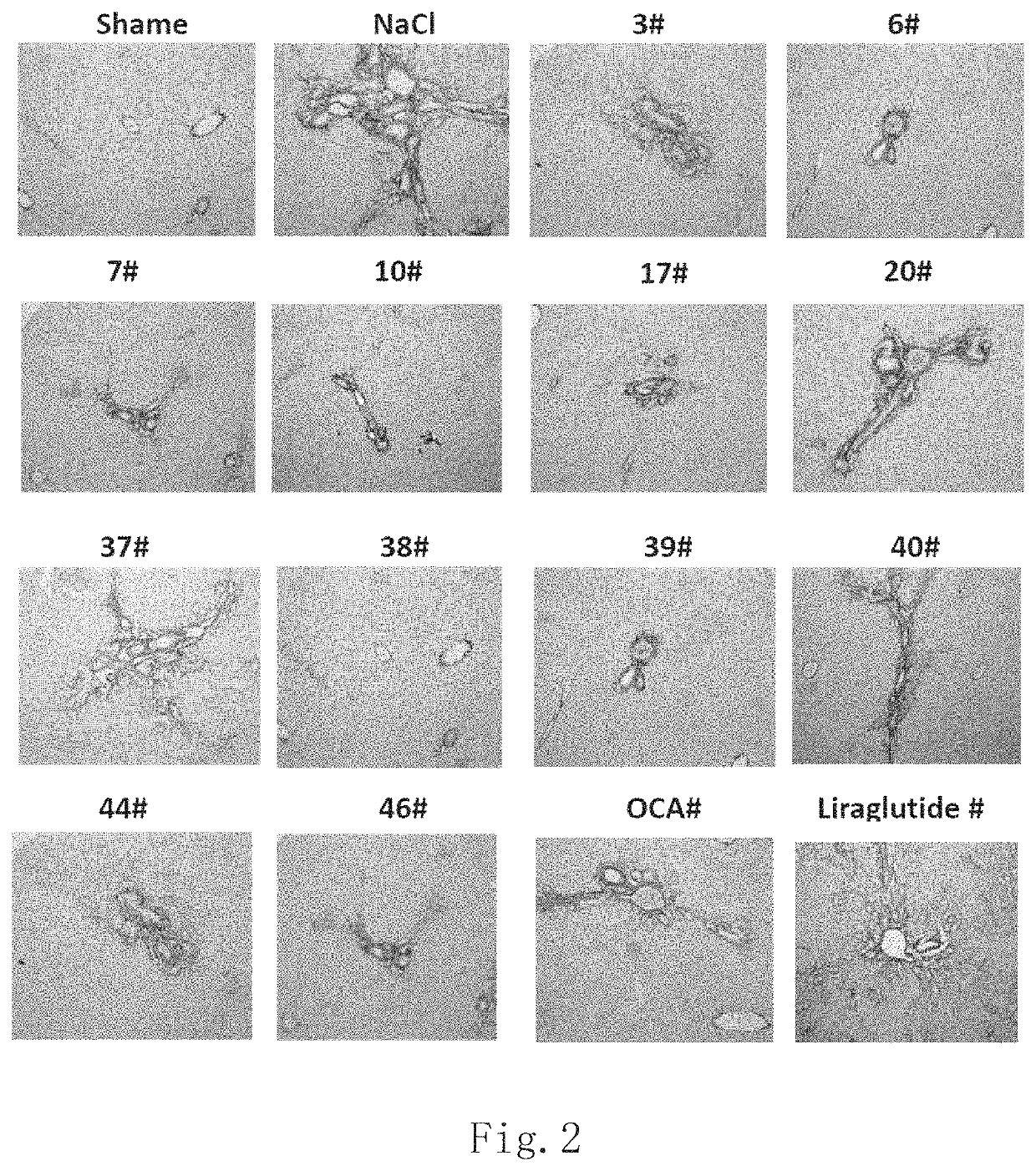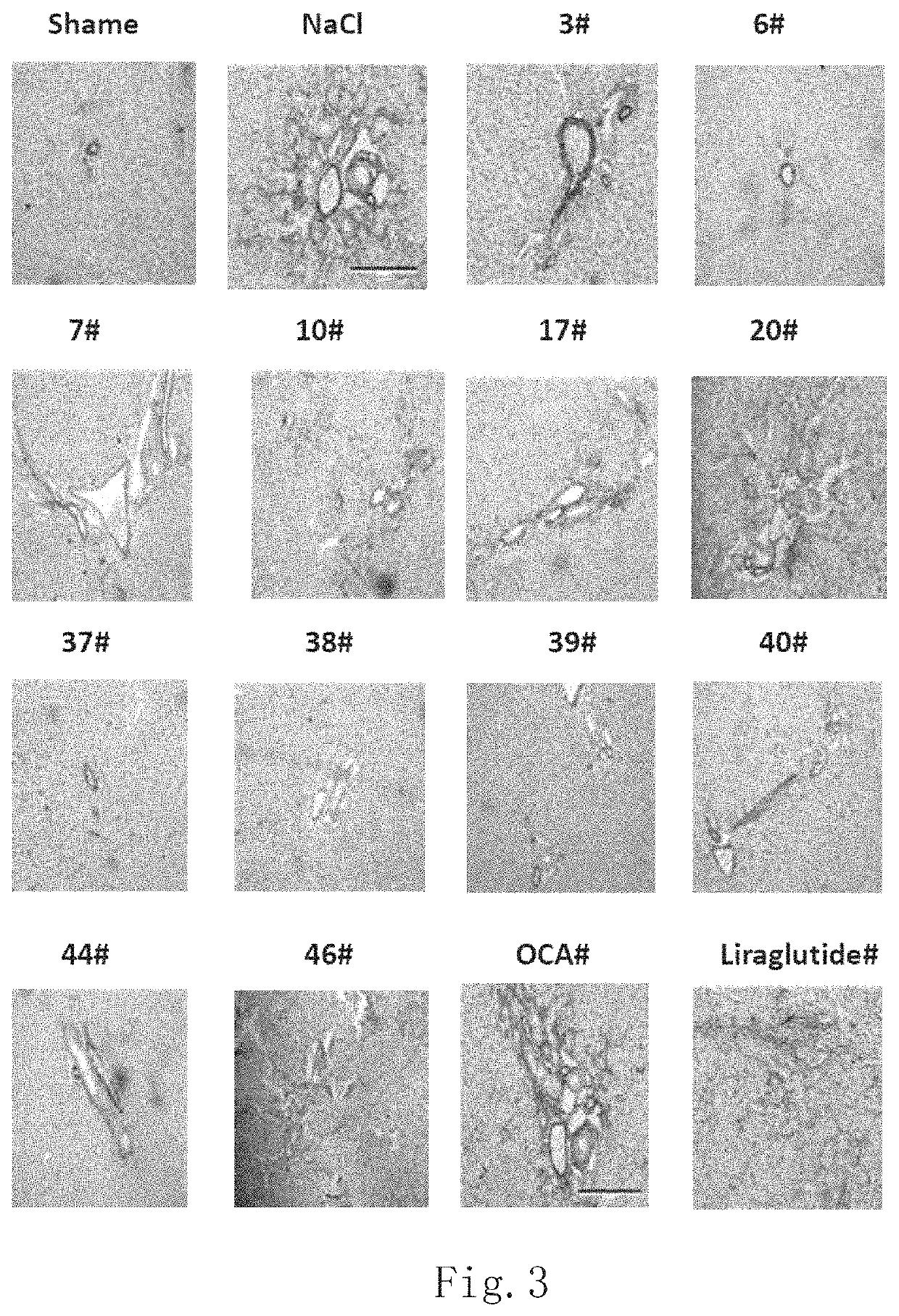Treatment of biliary cirrhosis based on oxyntomodulin analogue GLP-1R/GCGR dual-target agonist peptide
a dual-target agonist and biliary cirrhosis technology, applied in the field of biochemical technology, can solve the problems of hepatic fibrosis, adverse reactions of obeticholic acid, hyperplasia of fibrous tissues, etc., and achieve the effect of reducing the number of side effects, and improving the effect of obeticholic acid
- Summary
- Abstract
- Description
- Claims
- Application Information
AI Technical Summary
Benefits of technology
Problems solved by technology
Method used
Image
Examples
example 1
Synthesis of Polypeptide Compound
[0061]Materials:
[0062]All amino acids were purchased from NovaBiochem Company. Unless otherwise specified, all other reagents were analytically pure and purchased from Sigma Company. Protein Technologies PRELUDE 6-channel polypeptide synthesizer was used. Phenomenex Luna C18 preparative column (46 mm×250 mm) was used for purification of the polypeptides. High performance liquid chromatograph was manufactured by Waters Company. MS analysis was determined using Agilent mass spectrometer.
[0063]Synthetic method of polypeptide compounds of the invention is illustrated by taking the polypeptide compound 6 (SEQ ID NO: 6) as an example: Structure sequence (SEQ ID NO: 6):
[0064]His-(D-Ser)-Gln-Gly-Thr-Phe-Thr-Ser-Asp-Tyr-Ser-Lys-Tyr-Leu-Asp-Lys (PEG2-PEG2-γGlu-CO(CH2)14CH3)-Arg-Arg-Ala-Gln-Asp-Phe-Val-Gln-Trp-Leu-Met-Asn-Thr-Gly-Gly-Pro-Ser-Ser-Gly-Ala-Pro-Pro-Pro-Ser-NH2
[0065]a) Main Peptide Chain Assembly:
[0066]The following polypeptide in a scale of 0.25 m...
example 2
Inhibition Effect of GLP-1R / GCGR Dual Target Agonist Polypeptides on Hepatic Fibrosis
[0087]Hepatic stellate cell strain LX-2 was selected to study and observe the effect of different doses of test substances on the expression of LX-2 cell activation marker α-SMA.
[0088]Hepatic stellate cell LX-2 was laid on 35 mm cell culture plate, cultured with DMEM (high glucose)+10% FBS+1% double-antibody culture medium (Thermo Fisher), placed overnight when the cells grew to 70% convergence at 37° C. and under the condition of 5% CO2, and treated with the above GLP-1R / GCGR dual target agonist polypeptides 1-48 (dissolved in PBS) for 48 hours the next day morning to extract cell protein, carry out Western Blot, and take β-actin as internal reference and analyze the expression quantities of α-SMA and β-actin by a gray level of Image J 1.50i. PBS with the same volume as that in experimental group was added in negative control.
[0089]10 μM of the above polypeptide compounds were treated, and could be...
example 3
of GLP-1R / GCGR Dual Target Agonist Polypeptides to Improve and Treat Bile Duct Ligation (BDL)-Induced Hepatic Fibrosis in Rats (Biliary Cirrhosis Rat Model)
[0093]1. Experimental Drugs: polypeptide compounds 3, 6, 7, 10, 17, 20, 37, 38, 39, 40, 44, 46, Obeticholic Acid (Abbr. OCA, CAS:459789-99-2, purchased from Zhejiang Warrant Pharmaceutical Co., Ltd.) and Liraglutide. Saving condition was −20° C.
[0094]2. Experimental Method:
[0095]128 male SD rats with body weight of 200-230 g were randomly divided into sixteen groups, which were respectively:
[0096]1) Sham-operated group (Shame group with only free common bile duct, no ligation, n=8);
[0097]2) BDL+ normal saline control group (NaCl group, subcutaneous injection normal saline after BDL operation, n=8);
[0098]3) BDL+3 (50 μg / Kg) group (subcutaneous injection with 50 μg / Kg after BDL operation, n=8);
[0099]4) BDL+6 (50 μg / Kg) group (subcutaneous injection with 50 μg / Kg after BDL operation, n=8);
[0100]5) BDL+7 (50 μg / Kg) group (subcutaneou...
PUM
| Property | Measurement | Unit |
|---|---|---|
| time | aaaaa | aaaaa |
| flow rate | aaaaa | aaaaa |
| body weight | aaaaa | aaaaa |
Abstract
Description
Claims
Application Information
 Login to View More
Login to View More - R&D
- Intellectual Property
- Life Sciences
- Materials
- Tech Scout
- Unparalleled Data Quality
- Higher Quality Content
- 60% Fewer Hallucinations
Browse by: Latest US Patents, China's latest patents, Technical Efficacy Thesaurus, Application Domain, Technology Topic, Popular Technical Reports.
© 2025 PatSnap. All rights reserved.Legal|Privacy policy|Modern Slavery Act Transparency Statement|Sitemap|About US| Contact US: help@patsnap.com



